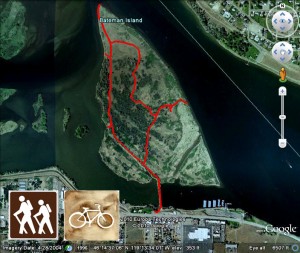■Round-trip mileage: 2.8 miles + (island loop)
■Difficulty: Easy
■Elevation: Steady at approximately 300 feet (river level). There is a small incline down and then back up to the parking lot.
■Warning: Standing and Running Water, keep a close eye on children.
View Bateman Island in a larger map
Sunrise on Bateman Island blog post
If you like birdwatching, Bateman Island is one of the finest riparian habitats in the Tri-Cities area. Plus, the island has quite a history including farming the the Lewis and Clark expedition. More details below.
Directions to the trailhead:
To get to the trailhead, take the Columbia Center Boulevard exit off Highway 240 and turn north (towards the river). At the T in the road, turn left on Columbia Park Trail and pull into the paved parking lot on the north side of the road.
Go through the break in the chain-link fence and down the hill to the causeway to Bateman Island.
This is a wonderful hike that is easily accessible. You can make a loop around the island that ends up being approximately 2.8 miles. There are several side trails to get to the river’s edge. Walk slowly and quietly and bring your binoculars for plenty of great birdwatching. The easiest way to make the loop is to stay to the left on the main trail as it follows the west shore of the island. You’ll get to the northwest point of the island and get a great view of the confluence of the Yakima and Columbia Rivers. Backtrack a bit to the road to the right and you can follow that back to the start for your loop. There is a nice side trail on the way back which takes you to the northeast shore of the island. Along with the abundant birdlife, there is plenty of other wildlife to watch for.There was a wildfire on Bateman Island in 2001 that burned many of the mature trees. There is plenty of evidence of the fire in burned trunks and trees but there is plenty of fresh, new growth and habitat as the island naturally rebounds from the fire.You can refer to my GPS tracing on Google Earth above for the trail. Also, here’s a map of the island trails found on a sign at the trailhead:
The rest of the text from the sign is as follows:
The Chamnupum Indians lived, fished, hunted and gathered plants in the Yakima River Delta area. Their main village of Chamna was believed to have been near Columbia Point. The Grants began farming on the island in 1872. By 1912, Riverview Ranch was using the island for raising dairy cows and hogs. From 1941 to 1952, the Batemans farmed here and raised turkeys. Because the area was farmed extensively, few native plants remain. However, if you look closely, you will see Black Cottonwoods, Willow Chokecherry, Lupine, Balsamroot, Bitterbrush, Service Berry, Wild Roses, Licorice Root, Greasewood, Dogwood, Primrose, Wild Geranium, Wormwood and Sagebrush. Coyote, Deer, Elk, Skunk, Muskrat, Mink, Beaver. The most abundant wildlife creatures are birds. Because of its extensive riparian habitat, you may see Robins, Sparrows, Grosbeaks, Juncoes, Warblers, Woodpeckers, Quail, Towhee, Owls, Waxwings, Thrushes, Pheasant, Magpies, Chickadees and Doves. In the water you can spot Loons, Grebes, Cormorants, Mergansers, Mallards, Wigeon, Ring-necked, Teal, Golden-eye, Bufflehead, Scalp, Redhead, Ruddy, Canvasbacks and Wood Ducks, Coot and Gulls. Near the water, watch for Swallows, Rails, Oriole, Belted Kingfishers, Chat, Crows, Terns, Geese, Nighthawks, Wrens, Kinglets, Phalarope, Snipe, Curlew, Yellowlegs, Sandpiper, Swans, Pelican, Heron, Golden and Bald Eagles, Hawks, Blackbirds, Finches, Phoebes, Flycatchers, Kingbirds, Nuthatch, Vireo, Killdeer, Plaver, Dowitches, Dunlin and Avocet.
Wikipedia includes the following information about Bateman Island:
Lewis and Clark mentioned Bateman Island in their journals in 1805. William Clark and two other men made their way towards the mouth of the Yakima River, but due to the time the farthest they got was Bateman Island.
“ …I took two men in a Small Canoe and assended the Columbia river [10 miles (16 km)] to an Island near the Stard. Shore on which two large Mat Lodges of Indians were drying Salmon,…there is no timber of any Sort except Small willow bushes in Sight in any direction – from this Island the natives showed me the enterance of a large Westerly fork which they Call Tâpetêtt at about 8 miles distant, the evening being late I deturmined to return to the forks, at which place I reached at Dark… “



